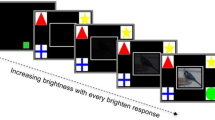Abstract
The sense of self-agency results from monitoring the relationship between prior thoughts and action plans, sensorimotor information, and perceived outcomes. It is thought to be an important factor underlying self-recognition and self-awareness. Three experiments investigated the sense of self-agency in humans and rhesus macaques (Macaca mulatta). First, humans were asked to move a cursor with a joystick while several distractor cursors also moved on-screen. They were asked to identify either the cursor they were controlling, or a distractor using visual cues alone. Six rhesus macaques were then given a similar task in which they needed to identify a self-controlled cursor that was paired with several different types of distractors. Both groups were able to identify the self-controlled cursor, and monkeys performed best when the oppositely moving cursor was the distractor. A third experiment showed that humans, like macaques, use both perceptual and self-agency information to make decisions.




Similar content being viewed by others
References
Amsterdam B (1972) Mirror self-image reactions before age two. Dev Psychobiol 5:297–305
Averbeck BB, Chafee MV, Crowe DA, Georgopoulos AP (2002) Parallel processing of serial movements in prefrontal cortex. Proc Natl Acad Sci USA 99:13172–13177
Blakemore SJ, Frith CD, Wolpert DW (2001) The cerebellum is involved in predicting the sensory consequences of action. NeuroReport 12:1879–1885
Briscoe RE (2011) The elusive experience of agency. Top Cogn Sci 3:262–267
Cheney DL, Seyfarth RM (1990) How monkeys see the world. University of Chicago Press, Chicago
Couchman JJ (2012) Self-agency in rhesus monkeys. Biol Lett 8:39–41
Couchman JJ, Coutinho MVC, Beran MJ, Smith JD (2010) Beyond stimulus cues and reinforcement signals: a new approach to animal metacognition. J Compart Psychol 124:356–368
Couchman JJ, Beasley R, Pfordresher PQ (2012) The experience of agency in sequence production with altered feedback. Conscious Cogn 21:186–203
Cowey A, Stoerig P (1995) Blindsight in monkeys. Nature 373:247–249
Desmurget M, Reilly KT, Richard N, Szathmari A, Mottolese C, Sirigu A (2009) Movement intention after parietal cortex stimulation in humans. Science 324:811–813
Gallup GG (1982) Self-awareness and the emergence of mind in primates. Am J Primatol 2:237–248
Gallup GG, Anderson JR, Shilito DJ (2002) In: Bekoff M, Allen C, Burghardt GM (eds)The cognitive animal: empirical and theoretical perspectives on animal cognition, MIT Press, Cambridge
Hare B, Call J, Agnetta B, Tomasello M (2000) Chimpanzees know what conspecifics do and do not see. Anim Behav 59:771–785
Jensen G, Altschul D, Terrace H (2013) Monkeys would rather see and do: preference for agentic control in rhesus macaques. Exp Brain Res 229:429–442
Kaneko T, Tomonaga M (2011) The perception of self-agency in chimpanzees (Pan troglodytes). Proc R Soc B: Biol Sci 278:3694–3702
Kircher TTJ, Leube DT (2003) Self-consciousness, self-agency, and schizophrenia. Conscious Cogn 12:656–669
Lethmate J, Dücker G (1973) Untersuchungen zum selbsterkennen im spiegel bei orangutans und einigen anderen Affenarten. Z Tierpsychol 33:248–269
Luu P, Flaisch T, Tucker DM (2000) Medial frontal cortex in action monitoring. J Neurosci 20:464–469
Macellini S, Ferrari PF, Bonini L, Fogassi L, Paukner A (2010) A modified mark test for own-body recognition in pig-tailed macaques (Macaca nemestrina). Anim Cogn 13:631–639
Matsumoto K, Tanaka K (2004) Conflict and cognitive control. Science 303:969–970
Metcalfe J, Greene MJ (2007) Metacognition of agency. J Exp Psychol Gen 136:184–199
Pacherie E (2012) The phenomenology of joint action: self-agency vs. joint-agency. In: Seemann A (ed) Joint attention: new developments. MIT Press, Cambridge
Pepperberg IM, Garcia SE, Jackson EC, Marconi S (1995) Mirror use by African grey parrots (Psittacus erithacus). J Compart Psychol 109:182–195
Plotnik JM, Lair R, Suphachoksahakun W, de Waal FBM (2011) Elephants know when they need a helping trunk in a cooperative task. Proc Natl Acad Sci USA 108:5116–5121
Prior H, Schwarz A, Güntürkün O (2008) Mirror-induced behavior in the magpie (Pica pica): evidence of self-recognition. PLOS Bio 6:1642–1650
Reiss D, Marino L (2001) Mirror self-recognition in the bottlenose dolphin: a case of cognitive convergence. Proc Natl Acad Sci USA 98:5937–5942
Repp BH, Knoblich G (2007) Toward a psychophysics of agency: detecting gain and loss of control over auditory action effects. J Exp Psychol Hum Percept Perform 33:469–482
Ridderinkhof KR, Ullsperger M, Crone EA, Nieuwenhuis S (2004) The role of medial frontal cortex in cognitive control. Science 306:443–447
Smith JD, Couchman JJ, Beran MJ (2012) The highs and lows of theoretical interpretation in animal-metacognition research. Philos Trans R Soc B 367:1297–1309
Spence I, Feng J (2010) Video games and spatial cognition. Rev Gen Psychol 14:92–104
Suarez SD, Gallup GG (1986) Face touching in primates: a closer look. Am J Primatol 11:239–244
Terrace HS, Metcalfe J (2005) The missing link in cognition: origins of self-reflective consciousness. Oxford University Press, New York
Tomasello M, Call J (1997) Primate cognition. Oxford University Press, Oxford
Washburn DA, Rumbaugh DM (1992) Testing primates with joystick-based automated apparatus: lessons from the Language Research Center’s Computerized Test System. Behav Res Methods Instrum Comput 24:157–164
Wegner DM (2002) The illusion of conscious will. MIT Press, Cambridge
Acknowledgments
I thank J. David Smith, Peter Pfordresher, James Sawusch, Eduardo Mercado, Mariana Coutinho, and Joe Boomer from the University at Buffalo, and Ted Evans, Megan Hoffman, Mike Beran, and David Washburn from the Language Research Center, Georgia State University for comments and assistance. This work was supported by NSF Grant BCS-0956993 and NIH Grant HD-061455.
Author information
Authors and Affiliations
Corresponding author
Rights and permissions
About this article
Cite this article
Couchman, J.J. Humans and monkeys distinguish between self-generated, opposing, and random actions. Anim Cogn 18, 231–238 (2015). https://doi.org/10.1007/s10071-014-0792-6
Received:
Revised:
Accepted:
Published:
Issue Date:
DOI: https://doi.org/10.1007/s10071-014-0792-6




